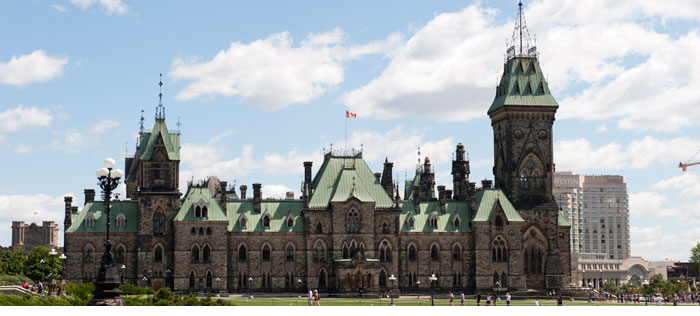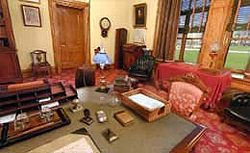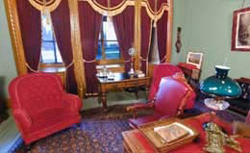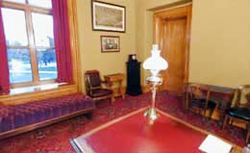East Block: History and design

Originally built to house the offices of senators and members of Parliament, the East Block held the offices of Sir John A. Macdonald and Sir George-Étienne Cartier. Today, it still houses the offices of senators and their staff. The building also contains faithful recreations of the offices of its famous occupants from the 19th century.
History
In 1859, the architects Thomas Stent and Augustus Laver designed the East Block in Gothic Revival-style.
They added a wing in 1910 to meet the needs for more government office space. The new wing linked the ends of the original building and was designed differently. At one time, the wing contained six huge vaults that stored the nation's financial treasures. Afterwards, the vaults were converted to office space, but the original doors were saved.
Office of Sir John A. Macdonald
Sir John A. Macdonald was Canada's first prime minister. He worked in the East Block from 1866 to 1873 and again from 1878 to 1883.
His office was beautiful—it had large Gothic stained glass windows, an elegant and colourful ceiling and a grand oak door. Despite the large windows, Macdonald still needed gas lamps to work after sunset. At the time, the central heating plant of the East Block could maintain a temperature of only 11°C during the winter—fortunately, the room had a fireplace!
Several of the office's furnishings are originals from the 19th century. Macdonald's double desk and horsehair sofa can still be seen.

Office of Sir George-Étienne Cartier
Before Confederation, Sir George-Étienne Cartier served as co-premier with Sir John A. Macdonald for Canada East in the Union government. The two men became great friends and leaders of the Confederation movement.
Cartier was Canada's first minister of militia and defence in 1872. His office was one of six that was built in the same style. It had large Gothic windows and beautiful furnishings and was painted in rich colours that exemplify the mid-Victorian era.
Every prime minister, from Sir Wilfrid Laurier to Pierre Trudeau, used this office. Over that time, its colours and furnishings were changed to reflect current tastes. The room was vacated in the 1970s. Since then, it has been restored to its early Confederation past. Gas lamps, coal fires, heavy draperies and rich colours complete the historic room.
Learn more about Sir George-Étienne Cartier.

Office of the Governor General
The responsibility of the Governor General has evolved since Confederation. Then, the monarchy's representative took an active and direct role in Canada. Now, the role is mainly ceremonial.
The large former office of the Governor General was restored to reflect the period around 1872. Back then, the Governor General and visiting royalty accessed the East Block through a special entrance, and a red carpeted stairway led the way to the room.

Privy Council Chamber
For more than 100 years, Cabinet met in the Privy Council Chamber to make decisions that would shape the course of Canadian history. For most of that time, no records were kept!
Great care was taken to create the ornate woodwork and mouldings that surround the Chamber. The walls were covered with gold-stencilled wallpaper. The bookshelves, window hangings and the impressive gasolier—a chandelier with gas burners—were more ornate and of finer quality than anything else in the East Block at that time.
As Cabinet grew, the Chamber underwent changes. A larger roundtable was introduced and a bright chandelier replaced the gasolier. The vibrant wall colours were repainted white to reflect changing tastes. In the 1920s, a proposal was considered to enlarge the Chamber by removing its west wall, but the plan was never carried out.
Cabinet eventually moved to the Centre Block, and in 1966, work began to rehabilitate the old Chamber. Using historic photographs, paint sampling and archival documents to determine the correct colours and finishes, fabrics and materials, every effort was made to faithfully recreate the Chamber as it was in 1872.

The Assistant Clerk's Office
The Assistant Clerk's Office sits beside the Privy Council Chamber. It was also recreated in the style of the early years of Confederation.
This room is a good example of an office that was provided for the lower ranks of the civil service. The doors, windows and mouldings are simpler than those found in ministers' offices. The chimney piece is the same design as marble ones also found in the building, but it is made of less expensive material.

More information
Learn about Restoring and modernizing the East Block